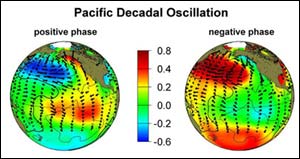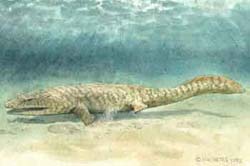Although a yearning to surf was what first drove native Tucsonan Edward Glenn to Hawaii, what keeps him going back is his life-long interest in marine agronomy. Now, instead of hanging out in the waves, Glenn spends his time on the leeward side of the island of Molokai, working with the local community on sustainable aquaculture projects for the ancient fishponds that dot the island’s south coast.
Rather than growing fish, Glenn, Stephen Nelson and their colleagues are focusing on the

Freighters, cruise lines, marine rescuers and coastal managers are among those who could benefit from prototype three-dimensional, three-day ocean condition forecasts created with the assistance of NASA satellite data, computer models and on-site ocean measurements.
Scientists hope to forecast ocean conditions several days ahead, much like regional weather forecasts broadcast on television news. “It’s a three-dimensional look at the ocean, from the surface to the ocean bottom,” said Yi
Ruby is mineralogically the chromiferous variety of corundum gemstone, in other words an aluminium oxide in which some of the aluminium ions have been substituted by chromium. Chromium contributes, along with vanadium, another metal constituent of ruby, to the crystal’s red colour. The most prized ruby deposits are those of Central and South-East Asia, like in the celebrated Mogok deposit in Myanmar (ex-Burma), from which the highest gem-quality rubies are extracted, reputed for their intense “pigeo

The cooler and drier conditions in Southern California over the last few years appear to be a direct result of a long-term ocean pattern known as the Pacific Decadal Oscillation (PDO), according to research presented at the 2004 meeting of the American Meteorological Society.
The study, by Steve LaDochy, associate professor of geography at California State University-Los Angeles; Bill Patzert, research oceanographer at NASA’s Jet Propulsion Laboratory in Pasadena, Calif.; and others, su

In the 19th century a fossil was uncovered in Belgium that was believed to be the jaw of a fish. Now a team of scientists have shown that it is in fact a fossil from an ancestor of all present-day land animals. It is the first discovery of a so-called tetrapod from the Devonian Period in continental Europe, which may trigger an interest in re-examining objects in museums.
In collaboration with researchers from France, England, and Belgium, Per Ahlberg, professor of evolutionary organism bio
Approximately 75,000 years ago, a massive explosive eruption from a volcano in western Indonesia (Toba caldera) coincided with the onset of the Earth’s last Ice Age.
In the current issue of Geology, University of Rhode Island geological oceanographers Meng-Yang Lee and Steven Carey; Chang-Hwa Chen and Yoshiyuki Iizuka of the Academia Sinica in Taiwan; and Kuo-Yen Wei of National Taiwan University describe their investigation into the possibility that eruptions from the Toba caldera on